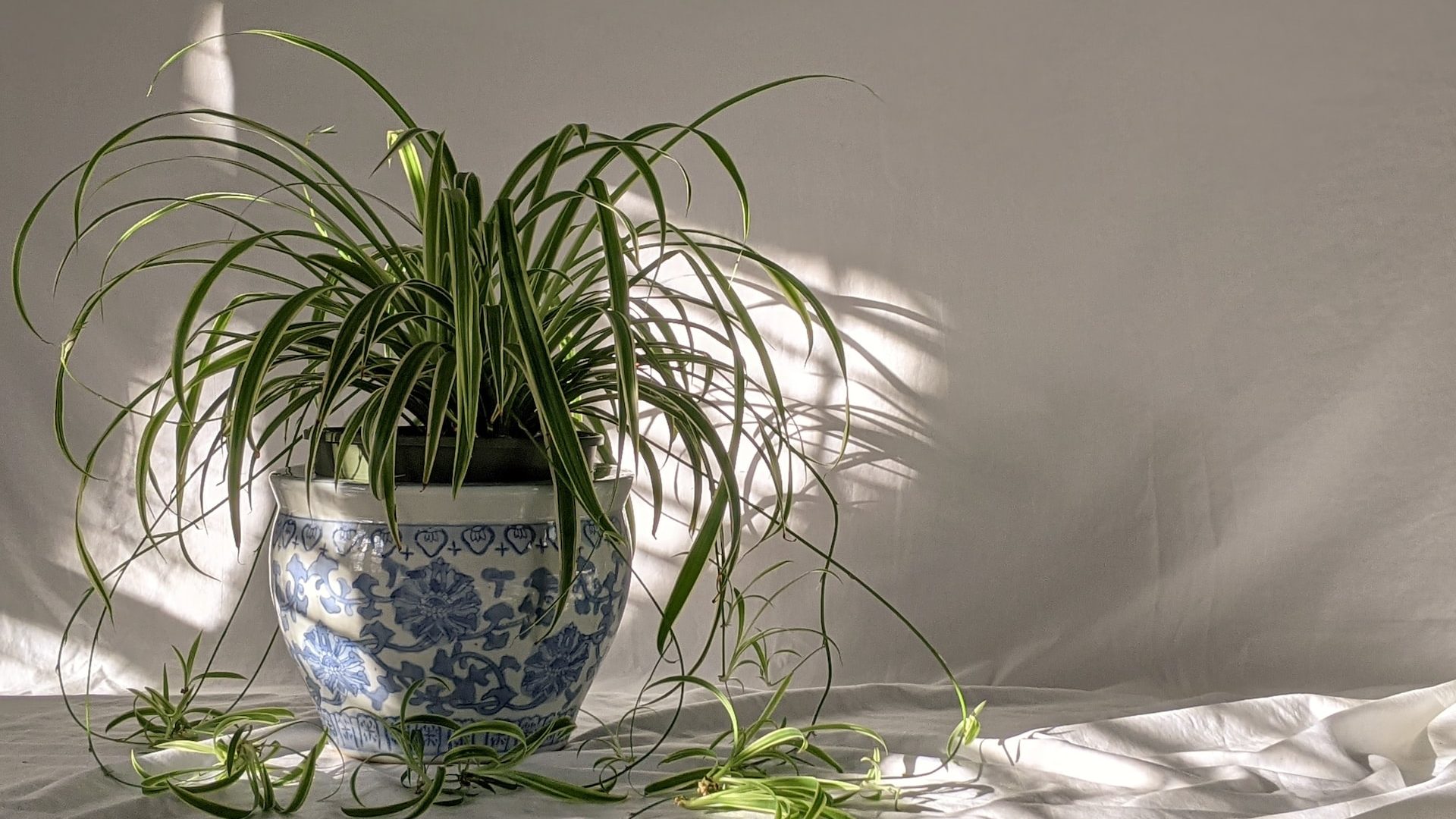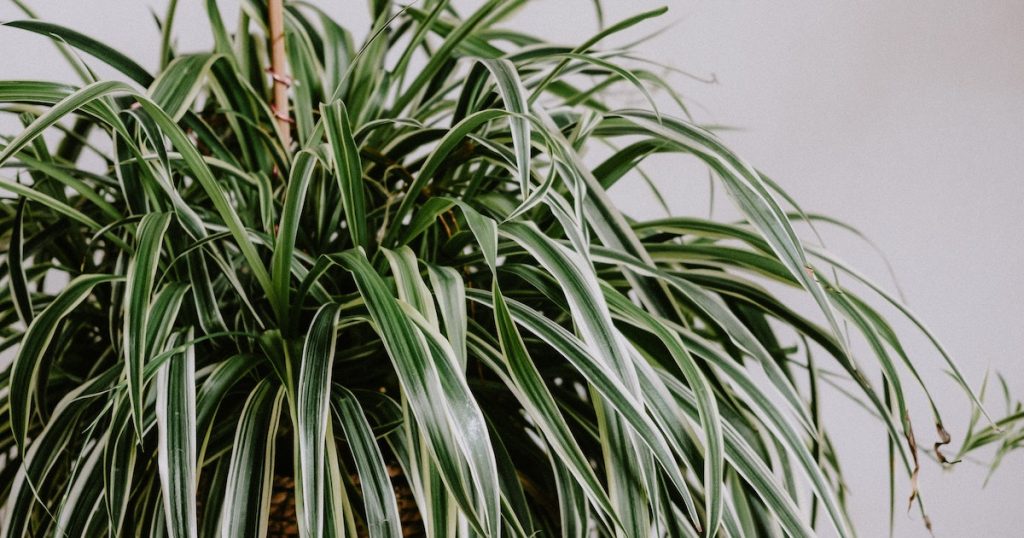Spider plants can be a beautiful addition to any home, and what makes them stand out the most is the beautiful variegated pattern on their leaves. These hardy plants are incredibly easy to take care of, but some owners ask the question – why does my spider plant not have stripes?
A lack of white stripes on your spider plant is an indication that it is not getting enough exposure to light. The plants need access to bright but indirect light in order to create variegated patterns on the leaves. This can be solved by moving them into an area with bright light or using artificial growing lights.
Keeping a spider plant at home is usually pretty easy, but if you want these plants to thrive, you need to be aware of the common issues that afflict them and how to solve each one. In this article, we will take a look at what to do to get stripes on your plants, along with solving some of the most common spider plant problems!

Table of Contents
Why Does My Spider Plant Not Have Stripes?
Spider plants are well-known for their white stripes that can create a fascinating pattern on their leaves. However, in some cases, you may have found yourself wondering – why does my spider plant not have stripes? The answer to that question can lie in your lighting situation.
The issue at hand is that spider plants that have variegation – which means the white stripes – can lose these patterns when they are kept in low light conditions for too long. As a result, the leaves of your spider plant will become a solid green color.
To take care of this issue, your best solution is to move the plant to a place where it can get bright light (although you should keep in mind that spider plants prefer indirect light). You can also use artificial growing lights, as many cheaper variants are now available online.
Solutions To Common Spider Plant Problems
A lack of white stripes isn’t the only problem that can afflict your spider plant. In fact, here are some of the most common issues you may come across, along with ways to solve them!
The Leaf Tips Are Becoming Brown
If you’ve kept a spider plant for a while, you may have noticed that over time, the leaves can look brown at the very tips. This is a problem that can be caused by a number of things. The most common issue at hand is that the spider plant is in need of more humidity. The simple way to take care of this is to mist your plants regularly or use a humidifier.
Sometimes, plants can also face this problem when they are exposed to too much direct sunlight. The tips of the spider plant are actually burning from this exposure. Therefore, you should move the plant to a spot where there is still bright light, but it is indirect.
Finally, a common cause for this is high levels of chlorine. Exposure to high chlorine can happen because of the water that you give your plant. To take care of this, try switching out the water you use for distilled water or purified water varieties that are low in chlorine.
Here are some maintenance tips for spider plants:
The Leaves Are Becoming Yellow
Aside from brown tips, sometimes you may notice that the spider plant is changing its leaf color from yellow to green. What could be causing this problem? In most cases, this is a result of bad watering hygiene, which means you are either overwatering the plant, or underwatering.
The question is, which one is it? You can usually tell if it is underwatered if the soil is completely dry, and the leaves have become especially dry and prone to breaking. On the other hand, an overwatered spider plant will have mushy leaves and constantly be in wet soil.
Determining how much to water a plant can be tricky, so make sure to do your research on the matter and adjust the watering schedule accordingly. Some home gardeners use a device known as a moisture meter to help them determine the exact amount of water they are adding.

The Entire Leaf Is Brown Or Black
One of the last things anyone wants to see is the leaves of their spider plant turning completely brown or even shifting to a black color. If this is the case, you can be sure that there is a significant problem at hand – root rot.
This is something that needs to be addressed as soon as possible, so the first thing you should do is change the soil you are using to one that drains water fast. Secondly, this means you will need to adjust the water routine because you are overwatering and drowning the roots.
Once you have done all this, you can remove the leaves that have become damaged and avoid watering the plant again until the soil is completely dry. If you do this in time, it is likely that the plant will be able to bounce back in the right conditions.
The Plant Is Drooping Severely
Finally, another issue you may come across with a spider plant is drooping. Luckily, this is one of the spider plant problems that can easily be addressed, as it is caused by underwatering. With a little bit of water and care, you will notice that the plant will immediately come back to life.
Any dried-out leaves can be removed, as they will not come back. However, another thing you can consider is its placement – too much exposure to sunlight can also dry out your spider plant. Ultimately, much of a spider plant’s maintenance comes from balancing water and light exposure.
Final Thoughts
If you are a long-term spider plant owner, there are bound to be some problems along the way. However, with the information provided above, you should now know how to deal with common issues like a lack of variegation.
In short, keep your spider plant healthy and happy by regularly watering and repotting, paying attention to its exposure to sunlight and other sources of heat, and removing damaged leaves as needed.
Recent Posts
Have you found yourself wondering, 'why is my bamboo growing so slow?' Despite the fact that bamboo plants are remarkably fast-growing, it can sometimes take months (or even years!) to see any signs...
Miracle-Gro is a huge help when you are trying to get decent yields out of your plants or if you want them to thrive. However, you may have noticed that a single dose of fertilizer does little to...
